人教版高中英语必修3Astronomy the science of the stars说课稿3篇
-
- 页数:10页
- 字数:约 17342 字
- 大小:96.50KB
- 格式:.doc
- 版本:Office2016及以上版本
- 作者:Riordon设计
Astronomy: the science of the stars说课稿3篇
必修3unit4说课稿一
Unit4 Astronomy: the science of the stars
Reading: How Life Began on the Earth
Interpretation
Good morning, ladies and gentlemen. It’s my great honor and pleasure to be here sharingmy lesson with you.

I have been ready to begin thisrepresentation with six parts. Analysis of the teaching material, the students,the teaching aims, the important and difficult points, the studying methods,and the teaching procedure.
Part 1 Teaching Material
The content of my lesson is New SeniorEnglish for China Book_3__ Unit_4_. This unit is about_Astronomy: the scienceof the stars. By studying of this unit, we’ll enable students to know sth. aboutastronomy and science of the stars and develop the interest in_science andlearning English.At the same time, let the students learn how to_use the nounclauses as the subject and distinguish the noun clauses as the subject and asthe object. From this lesson, it starts with warming up, pre-reading, readingand comprehending part. (As we all know, reading belongs to the input duringthe process of the language learning. The input has great effect on output,such as speaking and writing.) Therefore, this lesson is in the importantposition of this unit. If the Ss can master it well, it will be helpful forthem to learn the rest of this unit.
Part2 Analysis of the students
The students in Senior High School, gradeone have already learned English for years, they can speak and communicate withtheir friends in English. They are moderate, mature and sensitive. They are highlymotivated in learning English and have the ability to learn by themselves.Furthermore, the topic of this unit is about astronomy, which is full ofmystery, the students will have greater interest in learning it. However, thedifferences in english level among students is the biggest challenge. Thereforethe teacher should provide enough background information to make them better understandthe text. Therefore, I will adopt appropriate teaching methods to arouse theirinterest in learning.
Part 3 Teaching Aims
According to the new standard curriculumand the syllabus (新课程标准和教学大纲), and after studying the teachingmaterial, the teaching aims are the followings:
1.Knowledge objects (语言目标:语音,词汇,语法,功能,话题)
(1)The Ss can master the usage of theimportant words and expressions.
(2)The Ss can use the noun clauses as thesubject and as the object in the proper
situation.
(3)The Ss can understand the content ofthe lesson, talk about astronomy and get their own idea about protecting theearth.
2.Ability objects (技能目标:听,说,读,写)
(1) To develop the Ss’ abilities of listening, speaking, readingand writing
(2) To guide Ss to set up effectivestudying strategies.
(3) To improve the student’s reading ability, especially theirskimming and scanning ability.
(4) To train the Ss’ abilities of studying by themselves andcooperating .
3.Emotion or moral objects (情感目标:兴趣,自信,合作,爱国,国际视野)
(1)By completing the task, the Ss increasetheir interest in astronomy and science and set up self-confidence in learningEnglish and protect the earth in proper ways.
(2)Teach the Ss to cooperate with othersand cultivate the patriotic spirit and international visions, put the moraleducation in the language study.
Part 4 the Important and Difficult Points
Based on the requirement of the syllabus.The important points are_new words and expressions in the text, such as theory,billion, violent,fundamental, give birth to etc. The difficult points are theusages of noun clauses as the subject and as the object, how to distinguishthese two kinds of noun clauses.
Part 5 Teaching Methods
As is known to us all, a good teachingmethod requires that the teacher should help Ss develop good sense of theEnglish language. For achieving these teaching aims, (after the analysis of theteaching material and teaching aims,) I will use the following methodsaccording to the modern social communication teaching theories(现代社会交际教学理论) .
1. Communicative Approach(交际教学法)
2. Whole Language Teaching(整体语言教学法)
3. Task-based Language Teaching (任务教学法)
4. Total Situational Action (情景教学) a “scene — activity” teaching method , it establishes a realscene and the interaction between the teacher and the Ss. At the same time, CAI(电脑辅助教学) canprovide a real situation with its sound and picture, it can develop the Sscreativity in learning English.
Part 6 Teaching Procedure
Step1.Lead-in.(__10___min)
1.Ask students to read the questions inwarming up part, then discuss with their group members. After that ask severalrepresentatives to give their ideas.
2. Ask students: Do you know any bigevents in the astronomy in history? If you know, can you tell us sth. aboutthem? Are you interested in science? Do you know how earth began to form?
Purpose of my design: (1) to catch Ss’ attention about the class/topic/passage.
(2) To set up suspense/develop interest inthe astronomy and the science.
Step 2. Pre-reading
Task 1. ( pair work, __3___min)
Let Ss read the questions1-2 inpre-reading part, then work in pairs to find out the answers to the questions,then ask several students to express their ideas.
Task 2. (Individual work, __2___min)
Ask students to read the title and look atthe pictures. Predict what the reading will be about. Then ask one student tosay his/her guess.
Now, let’s see what happened in the text./ let’s check whether it is right or not.
Purpose of my design: (1) to get to knowsomething about how life began on the earth.
(2) To have a better understanding aboutthe importance of protecting the earth. Step 3. While-reading
Task 1. (Individual work __5___min)
Skimming: Ss should read the material fastto find out the main idea/topic sentence for each paragraph.
Para 1 ___________________
Para 2 ___________________
Para 3 ___________________ …
Task 2. (Individual work, __5___min)
Scanning
Read the passage carefully and then fillin the blanks with different kinds of living things.
Task 3. (Individual work __5___min)
Scanning: Guide Ss to read the materialcarefully and take some important notes, then finish th exercise 2 on P27.
Task 4. (Individual work, pair work, groupwork, class work; __5___min)
Scanning: Ask Ss to read the materialcarefully and find out the correct answers to finish the following questions.
This text can mainly divided into twostages
Stage 1 : The development of theearth(para.1-3)
(1) After the Big Bang, what was the earthlike?
(2) What happened next?
(3) What did the water vapour and gasesform?
(4) What appeared as the earth cooleddown?
(5) Why is water so important for thebeginning of life?
Stage 2 : The development oflife(para.4-5)
1.What life developed after waterappeared?
2.What life developed in water next?
3.What about the life on land?
4.What life developed next on land?
5.What life developed after forestsappeared?
6.What life developed after dinosaurs?
7.What life developed after mammals?
Purpose of my design: Enable students tounderstand the given material better by using different reading skills. Andproper competition can arouse the Ss’ interest in English learning. “Task-based” teaching method is used here to developthe Ss’ability of communication and also their ability of co-operation will be welltrained.
Step 4. Post-reading
Task 1. (Individual work __3___min)
Ask Ss to close books and finish thesummary according to their notes.
Retell the story /Sum up the passage in Ss’ own words according to the chart. Task 2.(group work, __7___min)
Discuss with other group members and thenchoose a reporter to share their opinions about the questions with the wholeclass.
How life began on earth is one of thebiggest puzzles that scientists found hard to solve.
1.What other puzzles are hidden in thepassage?
2. According to the evolution of life onthe earth, why was the earth different from the other planets?
3. Can you imagine the reason whydinosaurs disappeared?
4. As the earth is heavily polluted by ushumans, what should we do to make up for it?
Purpose of my design: I think If the Sscan finish this task well, they will benefit a lot in their spoken English.Most Ss can take their parts in the activities, especially for the Ss who havetrouble in English study.
Step 5. Homework
1. Review the new words and expressions inthe text
2. Finish the exercises 1-3 on P28.
Purpose of my design: Homework is soimportant and necessary for to master the knowledge they learned after class.It will check whether the Ss achieve the teaching aims.
必修3unit4说课稿二
必修三Unit 4 Astronomy: The science of the stars
Reading 公开课说课稿
一、说教材
本单元的中心话题是“天文学”,内容涉及太阳系、地球上的生命起源、宇宙大爆炸、月球探秘等,主要内容围绕地球上生命的起源展开的。本次阅读课“How Life Began On The Earth”通过对宇宙大爆炸理论进行科学性分析,推断出地球上生命的由来以及生物进化的过程。
二、说学生
“How Life Began On The Earth”这一话题虽然有趣,但本文的文体属于科普类说明文,内容抽象,用词多专业术语,阅读本文对高一学生来说有一定的难度.。不过本文以时间为线索,使得学生较易读懂本文的内容。通过对本文的阅读,学生不仅可以了解地球上生命的起源以及发展过程,还可以掌握一些相关的语言知识。
三、说教学目标
1. 知识目标:
(1)让学生在阅读中学到一些有用的单词和句子。
(2)让学生了解生命的起源。
2. 能力目标:
(1)提高学生的阅读技巧:略读,细读和对本文组织结构的分析。
(2)扩大学生对地球上生物进化的知识。
3. 情感目标:
(1)培养学生对科学的兴趣并激起学生对天文学的喜爱。
(2)调动和加强学生的环保意识。
四、说教学方法
1. 使用任务型教学,让学生明确学习目标。
2. 设计问答活动来检查学生对本文的了解。
3. 让学生在讨论中学会合作学习。
4. 分别利用个人,同桌和小组活动来完成学习任务。
五、说教学步骤
StepⅠ Leading-in (1mins)
Free talk with Ss: Is there life on themoon or other、planets?
设计意图:通过对Warming up的回忆引出本课话、题,了解学生对生命起源知识的掌握情况。
StepⅡ Pre-reading (4mins)
1. What’s the title of the text?Who are ourancestors?
Do you know some stories about it?
2. How did the universe begin? 设计意图:进一步激发学生的学习兴趣,激活其已有的知识,贴近了学生生活,又可以让学生对新单元的内容产生一种期待和渴望,使学生在心理上和认知上做好准备,激发他们对课文的学习兴趣并进行积极思考,从而培养其创造性的思维能力
StepⅢ While-reading (20-25mins)
Task 1: Skimming (5mins)
Read the passage quickly and match themain idea with each paragraph。设计意图:通过问题,使学生对本文有初步的了解,培养学生快速获取信息、解决问题的能力。
Task 2: Scanning (10-12mins)
Get Ss to read the passage once again andanswer the following questions.
1. When did the “Big Bang” happen?
2. What form was the earth after the “Big Bang”?
3. What made up the earth’s atmosphere?
4. How did water come into being on theearth?
5. What’s the importance of the presence of wateronthe earth?
6. What was important to the developmentof fish?
7. What made possible the rise of mammalson the earth?
8. Why are mammals different from all lifeforms in thepast?
Task 3: Read for the organization &logic (5mins)
1. By the way, what order is the passageorganized in? (Time order ).
2. Let Ss finish Exercise 2 on Page 27within 3 minuets and check the answers altogether. Let them work with theirpartners.设计意图:训练学生分析概括能力,培养学生捕捉信息以及归纳信息的能力,采用图文并茂的形式更加形象地帮助学生分析文章的结构和脉络,整体把握地球生命起源和进化的概况。
StepⅣ Post-reading (5mins)
Task 4: Group discussion: As a student,What can we do for taking care of the earth?
1. Let Ss turn around and discuss ingroups and then choose a spokesman for the group.
2. Collect the answers from the groups andshow the possible answers for Ss. 设计意图:训练学生回答问题并向全班汇报, 开拓学生的思维并锻炼他们的语言表达的能力,加强学生的环保意识, 从身边的小事做起。
StepⅤ Homework (2mins)
1. Read the passage after class andunderline the language
points you don’t understand in the text.
2. write a short passage about "Howto Protect the Earth" within 100 words.设计意图:训练学生正确运用所学的词汇,加深对课文内容和语言知识的理解,培养学生的归纳能力。
六、自我评价和反思
在本节课的准备和实施过程中,我始终牢牢把握《新课标》的思
想精髓,努力从学生实际和教学要求出发,内化和活化教材,为学生掌握知识创设情景、搭建平台,提供指导和服务。从课堂运行和对学生在课后的反馈来看,学生的参与面较广,积极性和学习的热情较高,更重要的是绝大多数同学能够完成课堂内外的训练题目,说明对知识的内化效果比较明显。通过课后思考,我也认识到课堂教学中还存在不尽如人意的地方,我会认真听取各位领导和同行老师的指教,积极学习,努力改进,力争把教学工作做得更好。在此,向大家对我的支持表示诚挚的感谢!
必修3unit4说课稿三
Unit 2 Astronomy: the science of the stars—Listening and discussing
Good morning/afternoon, everyone! Im veryglad to stand here to interpret my lesson. Today my topic is “Astronomy: the science of the stars”(Listening and
discussing part). I am going to introducemy lesson from the following aspects: the analysis of teaching material andstudents, teaching aims, teaching key points and different points, teaching andstudying methods, teaching procedures and blackboard design.
Ⅰ. Analysis of the teaching material
First of all, let’s focus on the analysis of teachingmaterial. This unit is about
astronomy, for example, the origin ofearth, the theory of the Big Bang. The listening part is about the developmentof gravity and it can help students be more curious about astronomy.
Ⅱ. Analysis of the students
Then, I’d like to talk something about mystudents. They already have learned
some basic listening skills, while theyare very unfamiliar to the gravity . Therefore, I will ask them to search moreinformation about the gravity before the class and thus make a good foundationfor this class.
Ⅲ. Analysis of the teaching aims
Based on the syllabus and the analysis ofteaching material and students, I set the teaching aims as follows:
Knowledge aims:
1. Students will get to know some usefulwords and expressions.
2. Students will know some scienceknowledge about gravity.
Ability aims:
1.Students can enhance their noting andgetting information ability.
2.Students’ reading and speaking ability can beimproved by the end of the class. Emotional aims:
1.Students will know more about astronomyand stimulate their love for science.
2. their team work spirit can also beimproved by the end of this lesson.
Ⅳ. Analysis of the key and difficult points
According to the aims of three-dimension,the key point of this lesson is to get Students know something about astronomyand enhance their capacity of
generalization and get the main idea. Andthe difficult point is that students can understand how the idea of gravity hasdeveloped over a long period of time.
Ⅴ. Analysis of teaching and studyingmethods
To help students achieve the teaching aimsmuch easier, I will mainly use
task-based teaching method, multimediamethod and communicative teaching method and so on. For students, I willencourage them to learn to cooperate with their classmates to let them becomethe real host of the class. 备考指导
Ⅵ. Analysis of the teaching procedures
Step 1 Warming up
After greeting with students ,I will askstudents to talk about their favorite
scientists. Before they talk about theirfavorite scientists ,I will tell them my favorite scientists Qian Xuesen likethis: My favorite scientists is Qian Xuesen. He refuse the invitation ofAmerican government and came back to china, making a great
contribution to the development of Chinesescience .How about you ? Who is your
favorite scientist?
您可能喜欢的文档
查看更多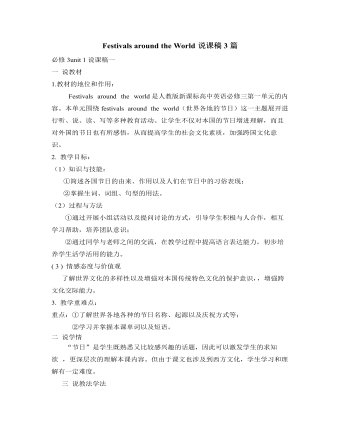
人教版高中英语必修3Festivals around the World说课稿3篇
- 页数:8页
- |大小:81.00KB
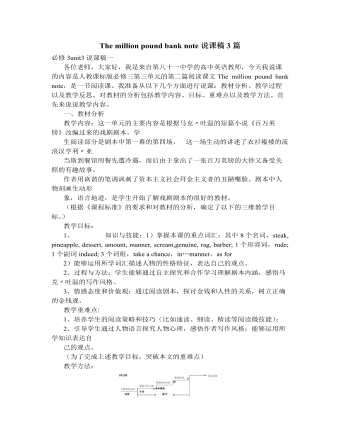
人教版高中英语必修3The million pound bank note说课稿3篇
- 页数:10页
- |大小:122.50KB
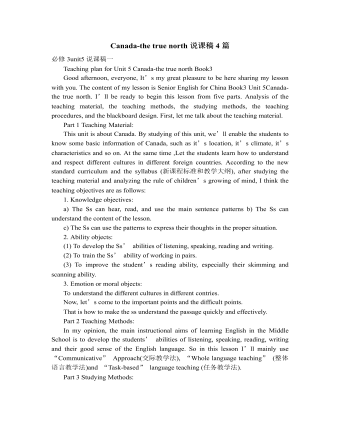
人教版高中英语必修3Canada-the true north说课稿4篇
- 页数:10页
- |大小:102.50KB
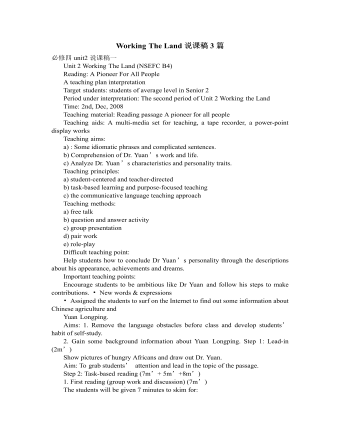
人教版高中英语必修4Working The Land说课稿3篇
- 页数:6页
- |大小:67.50KB
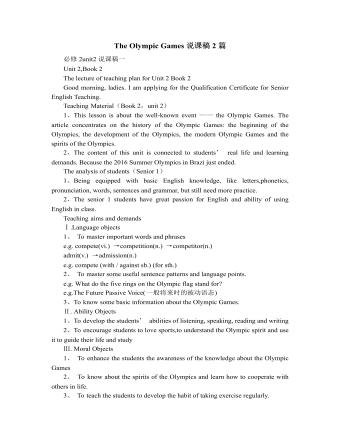
人教版高中英语必修2The Olympic Games说课稿2篇
- 页数:6页
- |大小:137.00KB
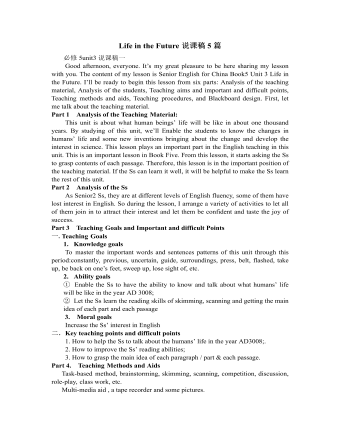
人教版高中英语必修5Life in the Future说课稿5篇
- 页数:26页
- |大小:363.50KB
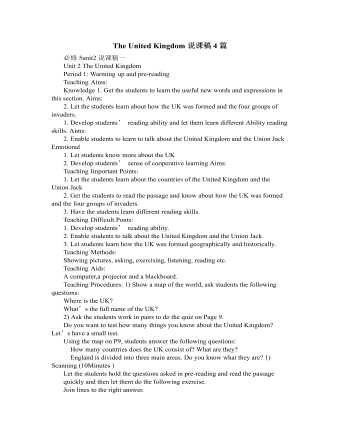
人教版高中英语必修5The United Kingdom说课稿4篇
- 页数:11页
- |大小:146.00KB
热门说课稿
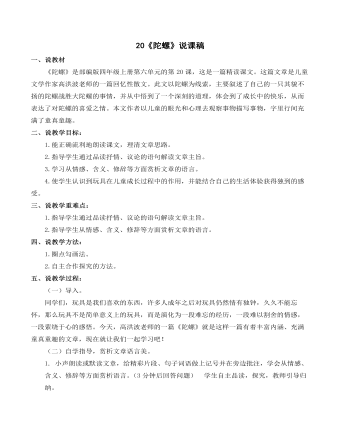
《陀螺》说课稿
- 页数:4页
- |大小:39.00KB
- 说课稿
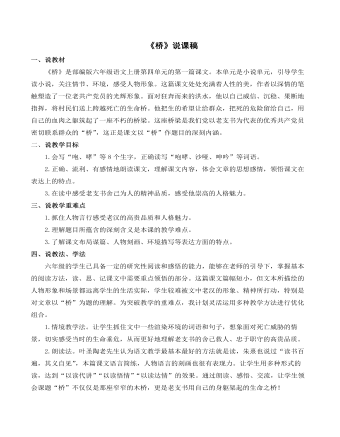
《桥》说课稿
- 页数:5页
- |大小:42.50KB
- 说课稿
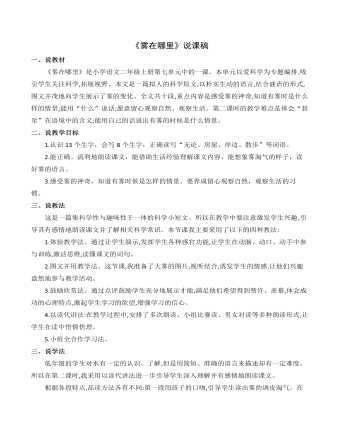
雾在哪里说课稿
- 页数:3页
- |大小:46.00KB
- 说课稿
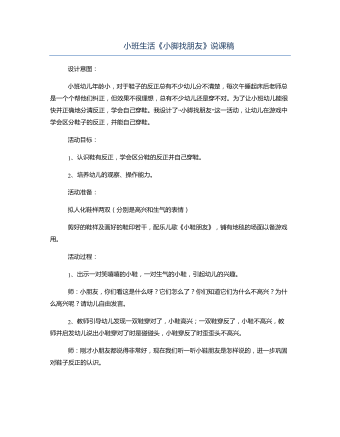
小班生活《小脚找朋友》说课稿
- 页数:2页
- |大小:33.31KB
- 说课稿
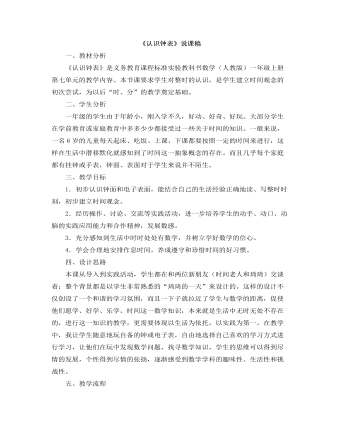
小学数学人教版一年级上册《认识钟表》说课稿
- 页数:4页
- |大小:24.27KB
- 说课稿
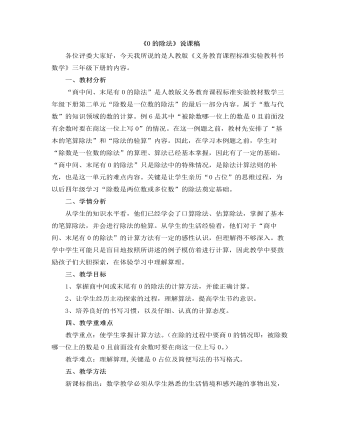
小学数学人教版三年级下册《0的除法》说课稿
- 页数:6页
- |大小:34.92KB
- 说课稿
今日更新

精选高中生期末评语
- 页数:42页
- |大小:7M

××县招商局2024年上半年工作总结
- 页数:12页
- |大小:142.54KB

“四零”承诺服务创建工作总结
- 页数:5页
- |大小:39.83KB
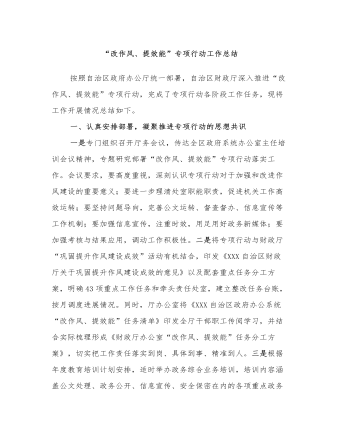
“改作风、提效能”专项行动工作总结
- 页数:6页
- |大小:139.05KB
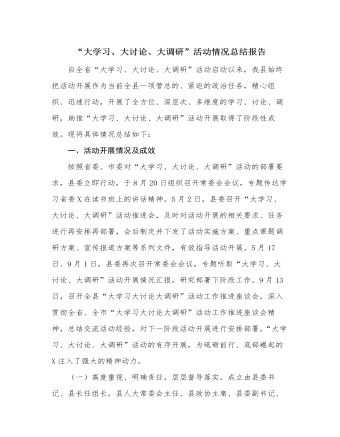
“大学习、大讨论、大调研”活动情况总结报告
- 页数:7页
- |大小:26.12KB
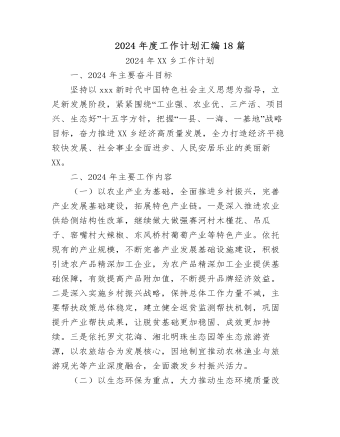
2024年度工作计划汇编(18篇)
- 页数:72页
- |大小:196.93KB





